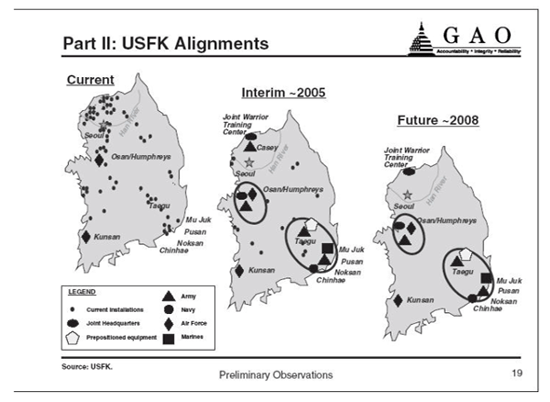NO US BASE | NEWS | PHOTO | CONTACT

|
The '1-4-2-1" strategy was first suggested in 2001, and formulated in 2002. Now that the strategy has been adopted, the US military must realign its troops to maximize the effectiveness of its global military transformation. On November 11, 2003 U.S. President George W. Bush announced the 'Global Posture Review (GPR) which called for repositioning of U.S. forces in Europe, Asia and other regions around the world. On August 16, 2004 Bush announced a major reduction: up to 60,000~70,000 U.S. military personnel in Germany and ROK over a ten year period. The current global deployment pattern of U.S. troops, including those in Europe and Asia, were established during the Cold War. However, the current deployment pattern makes little sense today. Therefore, the Global Posture Review and military transformation is a shift from static defense to a more easily deployable and usable set of capabilities. This shift is a fundamental change from a Europe centered military strategy to an Asia centered strategy, one which considers China as the potential enemy.
According to America's military strategy, the role of USFK is changing from a defensive posture against North Korea (for the last 50 years) towards a more flexible, rapidly deployable force for the wider Asia-Pacific region. Specifically, USFK will become more mobile and readily available throughout the Asia-Pacific. South Korea and the U.S. refer to this as "strategic flexibility" for the USFK. One goal of USFK transformation, and its broader focus as a rapid deployment force in the Asia-Pacific theater, is to constrain China. The United States has tightened its control over the Middle East, Central Asia, Southeast Asia and Northeast Asia; it has strengthened its ability to respond to this outstretched "arc of instability". By enveloping China, the U.S. attempts to deter the challenge and potential threat posed by a rising power. Moreover, the United States is prepared to intervene militarily if a conflict between China and Taiwan arises. Furthermore, the relocation to Pyeongtaek will put U.S. troops outside of North Korean missile range. This will give the United States time to respond to a North Korean attack, which the U.S. will be able to destroy within minutes. With air force (K-55) and naval forces in Pyeongtaek, the U.S. will be able to achieve their military goals by committing USFK troops throughout the Asia-Pacific region, including China and North Korea.
The U.S. will relocate USFK as part of its 'Global Posture Review' (GPR) plan. The U.S. will relocate Yongsan Garrison and the USFK Second Division to Pyeongtaek around 2008. Relocation plans will center around two major hubs in Pyeongtaek and Pusan/Daegu. The purpose of the Pyeongtaek relocation is to increase the capability of USFK into a rapid deployment force for the Asia-Pacific region. The U.S. will reduce its present level 37,000 troop force to 25,000 troops by the end of 2008. In 2005, 5,000 troops were already relocated. This move is related to military transformation, which is designed to maximize advanced technological capabilities.
According to U.S. military plans, the expansion of USFK's role relegates Korean military policy to a much more subordinate position. Meanwhile, the plan integrates the Korean military more tightly into the triangular ROK-U.S.-Japan military alliance. Lastly, the ROK becomes a forward base and staging ground for an invasion of China, and a logistic hub for wars fought overseas. The expansion of USFK's role in the Asia-Pacific implies U.S. troops will be stationed in Korea indefinitely. However, because ROK military capabilities are superior to North Korean capabilities, the U.S. has no reason to remain on the Korean Peninsula. Moreover, it forces the Korean military to increase its national defense budget and influences the formulation of military policy. Thus the expansion of USFK's role prevents peaceful unification of the Korean peninsula. It also prevents peaceful economic and security cooperation in Northeast Asia. Nevertheless, South Korea and the U.S. plan to enact legislation to expand the USFK's role through "strategic flexibility" meetings and the security policy meeting (SPI) of the ROK-U.S. military alliance. By reinterpreting the ROK-U.S. Mutual Defense Agreement through a joint statement, the two countries stretch the limits of the geographical application of the ROK-U.S. military alliance. Using ambiguous expressions such as "contribution to Asia-Pacific peace and stability", "disaster relief", and "prevention of terror and proliferation of weapons of mass destruction," the U.S. and ROK legalize the expanded role of the USFK. |
copylefted by Korea Coalition against U.S. base expantion in Pyeongtaek
